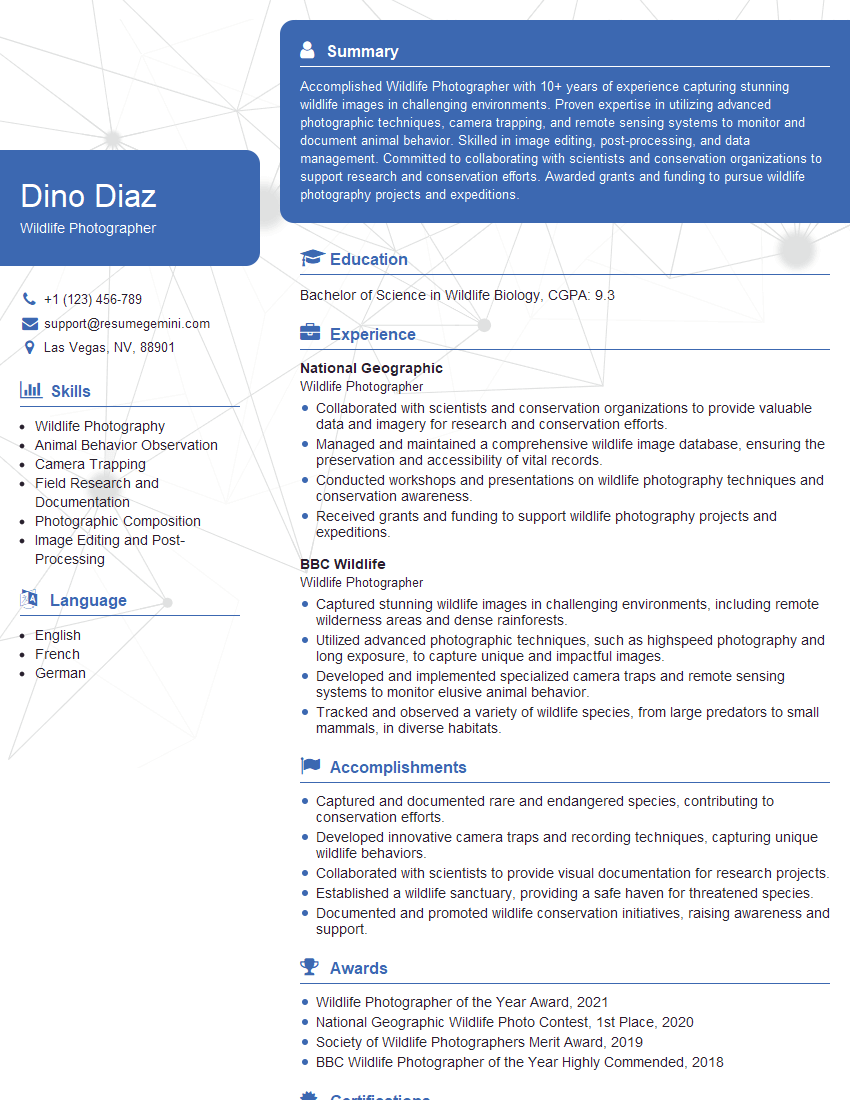Are you a seasoned Wildlife Photographer seeking a new career path? Discover our professionally built Wildlife Photographer Resume Template. This time-saving tool provides a solid foundation for your job search. Simply click “Edit Resume” to customize it with your unique experiences and achievements. Customize fonts and colors to match your personal style and increase your chances of landing your dream job. Explore more Resume Templates for additional options.

Dino Diaz
Wildlife Photographer
Summary
Accomplished Wildlife Photographer with 10+ years of experience capturing stunning wildlife images in challenging environments. Proven expertise in utilizing advanced photographic techniques, camera trapping, and remote sensing systems to monitor and document animal behavior. Skilled in image editing, post-processing, and data management. Committed to collaborating with scientists and conservation organizations to support research and conservation efforts. Awarded grants and funding to pursue wildlife photography projects and expeditions.
Education
Bachelor of Science in Wildlife Biology
July 2019
Skills
- Wildlife Photography
- Animal Behavior Observation
- Camera Trapping
- Field Research and Documentation
- Photographic Composition
- Image Editing and Post-Processing
Work Experience
Wildlife Photographer
- Collaborated with scientists and conservation organizations to provide valuable data and imagery for research and conservation efforts.
- Managed and maintained a comprehensive wildlife image database, ensuring the preservation and accessibility of vital records.
- Conducted workshops and presentations on wildlife photography techniques and conservation awareness.
- Received grants and funding to support wildlife photography projects and expeditions.
Wildlife Photographer
- Captured stunning wildlife images in challenging environments, including remote wilderness areas and dense rainforests.
- Utilized advanced photographic techniques, such as highspeed photography and long exposure, to capture unique and impactful images.
- Developed and implemented specialized camera traps and remote sensing systems to monitor elusive animal behavior.
- Tracked and observed a variety of wildlife species, from large predators to small mammals, in diverse habitats.
Accomplishments
- Captured and documented rare and endangered species, contributing to conservation efforts.
- Developed innovative camera traps and recording techniques, capturing unique wildlife behaviors.
- Collaborated with scientists to provide visual documentation for research projects.
- Established a wildlife sanctuary, providing a safe haven for threatened species.
- Documented and promoted wildlife conservation initiatives, raising awareness and support.
Awards
- Wildlife Photographer of the Year Award, 2021
- National Geographic Wildlife Photo Contest, 1st Place, 2020
- Society of Wildlife Photographers Merit Award, 2019
- BBC Wildlife Photographer of the Year Highly Commended, 2018
Certificates
- Certified Wildlife Biologist (CWB)
- Advanced Wildlife Photography (AWP)
- Ethical Wildlife Photography (EWP)
- Society for Conservation Biology (SCB) Membership
Career Expert Tips:
- Select the ideal resume template to showcase your professional experience effectively.
- Master the art of resume writing to highlight your unique qualifications and achievements.
- Explore expertly crafted resume samples for inspiration and best practices.
- Build your best resume for free this new year with ResumeGemini. Enjoy exclusive discounts on ATS optimized resume templates.
How To Write Resume For Wildlife Photographer
- Highlight your passion for wildlife and conservation in your resume summary.
- Showcase your technical proficiency in wildlife photography, including camera settings, lighting, and composition.
- Provide specific examples of your wildlife photography projects and expeditions.
- Quantify your accomplishments whenever possible, such as the number of images captured, species documented, or grants received.
- Proofread your resume carefully to ensure accuracy and professionalism.
Essential Experience Highlights for a Strong Wildlife Photographer Resume
- Capture compelling wildlife images in diverse habitats, including remote wilderness areas and dense rainforests.
- Utilize advanced photographic techniques, such as high-speed photography and long exposure, to capture unique and impactful images.
- Develop and implement specialized camera traps and remote sensing systems to monitor elusive animal behavior.
- Track and observe a variety of wildlife species, from large predators to small mammals, in diverse habitats.
- Collaborate with scientists and conservation organizations to provide valuable data and imagery for research and conservation efforts.
- Manage and maintain a comprehensive wildlife image database, ensuring the preservation and accessibility of vital records.
- Conduct workshops and presentations on wildlife photography techniques and conservation awareness.
Frequently Asked Questions (FAQ’s) For Wildlife Photographer
What are the primary responsibilities of a Wildlife Photographer?
Wildlife Photographers are responsible for capturing compelling images of wildlife in their natural habitats. They utilize advanced photography techniques and specialized equipment to document animal behavior and provide valuable data for research and conservation efforts.
What are the educational requirements to become a Wildlife Photographer?
Most Wildlife Photographers hold a Bachelor’s degree in Wildlife Biology, Ecology, or a related field. Additional training in photography and field research methods is also beneficial.
What are the key skills required for a successful Wildlife Photographer?
Wildlife Photographers should have strong photography skills, including a deep understanding of composition, lighting, and camera settings. They should also be proficient in field research methods and have a keen eye for detail.
What are the challenges of being a Wildlife Photographer?
Wildlife Photography can be physically and mentally demanding. It often involves working in remote wilderness areas, facing harsh weather conditions, and encountering potentially dangerous animals. Patience, resilience, and a deep respect for wildlife are essential.
What are the rewards of being a Wildlife Photographer?
Wildlife Photography offers the opportunity to witness and document the incredible diversity of the natural world. It allows photographers to contribute to scientific research, conservation efforts, and public awareness about wildlife and their habitats.